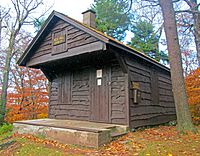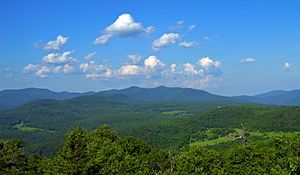Red Hill Fire Observation Station facts for kids
Quick facts for kids |
|
|
Red Hill Fire Observation Station
|
|

Fire tower in 2008
|
|
| Location | Denning, New York |
|---|---|
| Nearest city | Kingston, New York |
| Built | 1920 |
| Architect | Aermotor Corp. |
| MPS | Fire Observation Stations of New York State Forest Preserve MPS |
| NRHP reference No. | 01001030 |
| Added to NRHP | 2001 |
The Red Hill Fire Observation Station is a special place in the Catskill Mountains of Denning, New York. It includes a fire lookout tower, a small cabin, and a privy (an outdoor toilet). These buildings are located on the very top of Red Hill, a mountain that is about 2,990 feet (911 meters) high. This station is the southernmost fire tower in the entire Catskill Park.
Built in 1920, this tower was one of the last ones added by the state. It helped fill a gap in the Catskills' system for finding forest fires. People called "observers" worked in the tower for many years. They worked for state conservation groups until 1990. This made Red Hill the last fire tower to close in the Catskills.
Even after it closed, the tower and its amazing views remained popular with hikers. At first, there were plans to tear it down. This was because state rules said non-essential buildings should not be on Forest Preserve land. But people who cared about history and forests worked hard to save it. They also wanted to save four other Catskill fire towers. In the early 2000s, these towers were added to the National Register of Historic Places (NRHP). The observer's cabin at Red Hill is one of the oldest buildings of its kind in New York.
A short hiking trail was built to reach the tower. This was needed because the old road used by observers was closed by the private landowner. Today, hikers still enjoy climbing the peak and the tower. They love the wide views of the Catskill High Peaks to the north.
Contents
What is the Red Hill Fire Station Like?
The fire tower is a tall, 60-foot (18-meter) steel structure. It was made by a company called Aermotor. The tower is held firmly in place by bolts drilled into the rock. At the very top, there is a glass-enclosed cab. You reach this cab by climbing eight flights of stairs.
The tower stands in a grassy open area. This clearing is about 500 square feet (46 square meters). It is just east of the mountain's highest point. At the western end of the clearing, near the top of the trail, is a rustic one-room cabin. This is where the observers lived while they worked. A small wooden privy is located just north of the cabin. There are also two picnic tables between the cabin and the tower.
The Observer's Cabin
The cabin is a small, one-story building. It measures about 14 by 24 feet (4.3 by 7.3 meters). It has a gable roof, which means it has two sloping sides that meet at a ridge. The outside walls are made of "brainstorm" wood, which is stained reddish-brown. The cabin sits on a stone foundation made of rocks and mortar. It also has a covered porch on the south side. This porch was originally made of wood but is now concrete.
The cabin was built in 1931. It is one of the oldest observer's cabins still standing in New York. It is a rare example of the early style used by the state's Conservation Commission. Both the tower and the cabin are old enough to be considered important parts of the NRHP listing. The privy and picnic tables were added later for hikers and are not considered part of the historic listing.
A Look Back: History of the Fire Station
Why Were Fire Towers Built?
After the Forest Preserve was created in 1885, a big problem for New York was controlling and preventing forest fires. Sometimes, people who were logging illegally would burn their leftover wood (called "slash") without making sure the fire was completely out. Sparks from the steam locomotives (trains) in the area also caused many fires.
In 1889, a group called the Balsam Lake Club built the Catskills' first fire tower. It was on Balsam Lake Mountain. Twenty years later, after two very dry summers caused a lot of damage to the forests, the state took over this tower. They started a new plan, which had worked well in Maine. This plan involved putting trained observers in towers at important locations. These observers would spot the first signs of fire and report its exact location using telephone lines.
The state built its first tower on Hunter Mountain in Greene County in 1909. Within ten years, many more towers were built across the Catskills and in the nearby Shawangunks.
Building the Red Hill Tower
In 1919, the state's Conservation Commission realized there was still a large area in the southern Catskills that wasn't well covered by the existing towers. This area was in Sullivan and Ulster counties. Red Hill was chosen as the spot for a new tower.
In early 1920, a forest ranger brought the tower, taken apart, up to the summit. They used a horse-drawn wagon. A state crew then cut a road from the nearby Red Hill Road through the Dibble farm. They also put up the telephone line along this road. The tower and cabin were built later that year.
Life as a Fire Observer
The cabin you see today replaced the original one in 1931. Nothing else changed at the site during its active years. Former observers often spoke fondly of their job. The biggest danger was lightning strikes hitting the tower while they were inside. A few observers were slightly hurt by these strikes.
Many observers stayed busy by taking care of the road and telephone line. They also had hobbies like woodcarving. They would often welcome hikers and other visitors who came up the road from the Dibble farm. Sometimes, they had to live off the land. This meant gathering wild plants, like leeks, and hunting game in the nearby woods. The cabin did not have electricity. They got their water from a spring at the bottom of a small cliff. This spring was about 0.3 miles (0.5 km) from the tower.
In 1971, the state briefly closed the tower. But it reopened the next year because of communication problems in the area. The Dibble family sold their farm in the early 1980s. The new owner was not as welcoming to hikers. They closed the road to everyone except state workers. Soon after, the tower was closed again. The risk of fires had gone down since the early 1900s. This was because there were fewer trains and less logging. Also, people were better at reporting fires.
However, a new period of many fires led the state to reopen the tower in 1987. This time, it stayed open until 1990. It was the very last fire tower in the Catskills to be closed.
Saving the Tower
In the early 1990s, a forester named George Profous suggested that the old, worn-out tower should be taken down. This was because it was no longer used. State rules said that unused buildings were not allowed on Forest Preserve land. New York's constitution says this land must be kept "forever wild."
But people in Denning and the nearby hamlet of Claryville were worried. They contacted the Catskill Center for Conservation and Development. This group helps protect the region. They wanted to know how to save the tower. Mr. Profous had actually hoped for this! State rules do allow old buildings to stay if they help people understand the Forest Preserve better. Many visitors and past observers had written about how seeing the vast Catskill wildlands from the tower helped them appreciate the importance of protecting it.
Within a few years, the effort to save the towers grew. All five remaining Catskill fire towers were listed on the Historic Lookout Register. Later, they were added to the NRHP. The state provided grants (money). Local people also raised money through things like bake sales, dances, and raffling a quilt. This money helped start restoring the tower and cabin in 1998.
Volunteers from the New York–New Jersey Trail Conference helped too. They extended the path from the tower to the spring. They made it into a trail that stayed on state land. This new trail went down the mountain's untouched northwestern slope to a new trailhead. This avoided the closed road. All these efforts were finished in 2000. The Red Hill tower became the first of the restored Catskill fire towers to reopen to the public.
Visiting the Red Hill Fire Tower Today
The Red Hill Fire Tower is part of the Sundown Wild Forest area. The old road to the tower is still there, but it is now closed even to state workers. You can only reach the tower by hiking the trail. The trail starts on Dinch Road. This is an old, rocky dirt road that goes around the mountain's northwest side.
The trail follows yellow plastic markers. It is about 1.5 miles (2.4 km) long and climbs about 890 feet (271 meters) up to the tower. Along the way, you will see 10 numbered wooden signs. These signs match information in a special brochure made by the Red Hill Fire Tower Committee. You can get the brochure at the trail register. The signs point out different plant species that grow in the Catskill forests.
At the top, volunteer guides are often at the tower on good weather weekends. This is usually from late June to early October each year. Guides are also available on holiday weekends, like Columbus Day. Inside the tower's cab, there are paper cutouts. These help you identify the mountains and other places you can see. On clear days, you can see up to 50 miles (80 km) away!
The 360-degree panorama (view all around) is amazing. You can see Peekamoose and Table mountains. These are the southernmost of the Catskill High Peaks. You can also see other parts of the Slide Mountain Wilderness Area to the north. To the southeast, you can see the Shawangunk Ridge and the Hudson Valley beyond it. On very clear days, you might even see the river itself. You might also spot New Jersey's highest mountain, High Point. The view to the southwest reaches into Northeastern Pennsylvania's Poconos. These are like a southern extension of the Catskills. You might even see Elk Mountain, which is the highest mountain in Pennsylvania outside of the Alleghenies.
The cabin is also open for visitors. It acts as a small museum about fire protection in the Catskills. There are displays on the walls showing how fires were fought. You can also see items inside the cabin that show how observers lived. The porch and picnic tables are available for use. Since the mountain top is below 3,500 feet (1,067 meters) in height, camping is allowed there all year round.



